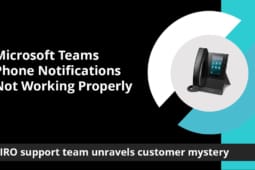After a title like this, I’m sure I have two things at this point: a firm grip on you attention, and a firmer grip on your blood pressure. However, there is more to the argument to come.
When it comes to Unified Communications, not only is Microsoft Teams not a magic bullet—neither are Cisco, Avaya, SAP, Zoom, or anyone else for that matter. And herein lies the issue.
For years, there has been this thought that every UC solution must revolve around a single vendor, a single platform, and in the end have some sort of built-in “forever” brand loyalty. That is no longer the case—not by a long shot. The idea that companies still have to stick to a one-brand-fits-all is nonsense.
So, back to the idea that I just picked a fight with Microsoft Teams, along with every other UC vendor in the world—it’s actually the exact opposite.
I for one love Microsoft Teams, as well as the entirety of the Microsoft 365 suite. Why wouldn’t I? It integrates with all of their office apps, it’s easy to configure and use, and it even dovetails perfectly into much larger Microsoft offerings such as SharePoint. Full disclosure, we at Stack8 use it ourselves.
But that doesn’t mean it’s the only solution—nor is it our only solution, nor should it be your only solution. Today’s business models require far greater care, greater planning and greater scope to survive in an ever-connected world. This means connecting to everyone and everything is going to require more than a single tool, or a single platform for that matter.
As digital transformation initiatives continue to thrive and grow, the fact of the matter is that multi-platform models are the only solution that companies can truly and fully rely on. Why, you ask? It’s all centered around the concept of cloud connectivity and the resulting processes that require far more horsepower than one vendor can offer.
I remember back in the good old days there used to be this saying in telecom: “You can have any color desk phone you’d like as long as it’s black.” Though comical in some ways, denoting that the lack of choice in even decorative colors was limited to one—the real issue here represented how businesses had to bend their will and resulting businesses processes to that of the telecom company. In short, the telecom company dictated the processes, not the other way around.
However, in 2020 and beyond, that paradigm has been reversed (I use that statement just to pick on my marketing friends … you know who you are).
All jokes and sarcasm aside, the advent of cloud computing—the foundation for digital transformation as a whole—now demands interconnectivity from all major vendors. To put it bluntly, cloud doesn’t nor can it limit compatibility.
So here we are—smack-dab in the middle of a multi-vendor world where every one of them know that keeping compatibility alive and well is their only road to success. For instance, there is a reason why Cisco Webex Teams meetings can be held “inside” a Microsoft Teams environment, all while using an 8×8 call center solution.
The fact of the matter is, this is the future. Gone are the days of single solutions—no one vendor can do it all. Conversely, as a company you must do it all on behalf of your brand and your customers. Developing a solid plan that details every process, every expectation and every desired experience will ultimately lead you down a road whereby multiple vendors will be required to make your system your own.
So let Microsoft Teams thrive inside your environment right beside your substantial Cisco investment, while trying to decide the perfect call center solution. It will all work together. Always.
Ready to take your unified communications from headache to hassle-free?
No throwing darts at proposals or contracts. No battling through the back-end. No nonsense, no run-around.



